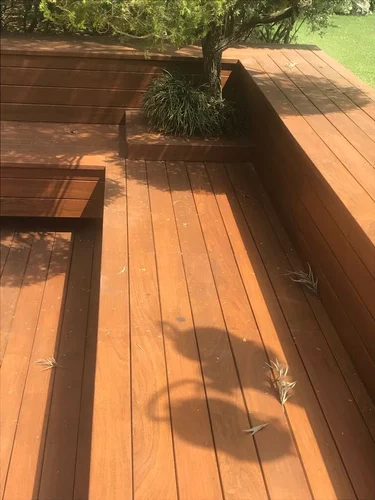Teak Wood Decking
₹350.0
Product Specification
| Color | Teak |
| Material | Wood |
| Deck Flooring Area | Pools, Courtyard |
| Thickness (mm) | 20-30 |
| Length | 10-20 m |
Product Description
- Our range of Deck Flooring is made of IPE, Lunawood, Teak Wood, WPC, etc. and is designed in such a way that it creates a non-slippery surface with a solid grip.
- These are mainly used for wet surroundings like swimming pools, gardens and parks non-slippery nature.
- These are also commonly used for the walkways and jogging tracks.
- We ensure that the offered services are executed with the help of advanced technology and machines.
- Also, our professionals are capable of rendering these services as per clients’ exact specifications.
- We have equipped our professionals with latest tools and machines so that the services offered to clients are timely completed.
- Also, our professionals understand each and every requirement of clients and provide designs as per the ambiance and environment at clients; site.
- Offered at market leading prices, these services are extensively demanded in market.
- As an esteemed organization of this domain, we are engrossed in presenting a broad spectrum of Outdoor Deck Flooring.
- Offered by us in numerous patterns, designs and combinations; these offered Outdoor Deck Wooden Flooring that is widely appreciated by the customers due to their reliability, abrasion resistance, dimensional accuracy and sophisticated look.
- Our offered outdoor deck flooring is manufactured using high-grade wood along with imported plastic to assure water resistance.
Features:
- Non-slippery
- Waterproof
- Rot-proof
- Easy to install
- No vibration noise
- Resistant to acid rain
- Low maintenance
- Resistant to impacts and breaking
- Attractive
- Durable
- Fine finish
- Light weight
- Termite proof
- Weather resistant
Applications:
- Pools
- Resorts
- Farm House
- Landscape
- Pergola loor
- Geometric pools
- Public Gardens
- House Courtyard and backyard
- Description
- Additional information
- Reviews (0)
- Q & A
- Sustainability Remark
- More Offers
- Store Policies
- Inquiries
| Material | WOOD |
|---|
You must be logged in to post a review.
Q & A
Low VOC Flooring Sustainability: Low VOC (Volatile Organic Compound) flooring refers to flooring materials that emit lower levels of harmful chemicals compared to traditional flooring options. These materials are typically manufactured with fewer toxic substances, which can contribute to improved indoor air quality and reduced environmental impact. Here are some aspects related to the sustainability of low VOC flooring:
Health Benefits: Low VOC flooring can help create a healthier indoor environment by minimizing the release of harmful chemicals. This is particularly beneficial for individuals with respiratory sensitivities or allergies.
Reduced Environmental Impact: Manufacturing low VOC flooring typically involves using fewer toxic chemicals and solvents. As a result, the production process can have a lower impact on air and water quality, reducing pollution and potential harm to ecosystems.
Energy Efficiency: Some low VOC flooring options, such as bamboo or cork, can be sourced from renewable materials. Choosing sustainable materials helps conserve natural resources and reduce the carbon footprint associated with the production and transportation of flooring materials.
Durability and Longevity: Sustainable flooring options are often designed to be durable and long-lasting. Choosing high-quality low VOC flooring can minimize the need for replacement, thereby reducing waste generation.
Recycling and Disposal: Sustainable flooring materials may be recyclable or made from recycled content. When it comes time to replace the flooring, look for recycling programs or proper disposal methods to ensure responsible waste management.
Water-Efficient Plumbing Sustainability: Water-efficient plumbing systems are designed to minimize water usage, promote conservation, and reduce water waste. Here are some points regarding the sustainability of water-efficient plumbing:
Water Conservation: Water-efficient plumbing fixtures, such as low-flow toilets, showerheads, and faucets, are designed to use less water without compromising performance. These fixtures can significantly reduce water consumption in homes and commercial buildings.
Energy Savings: Conserving water also leads to energy savings. Water treatment and distribution require energy, so reducing water usage reduces the associated energy consumption and greenhouse gas emissions.
Sustainable Landscaping: Water-efficient plumbing extends beyond indoor fixtures. Sustainable landscaping practices, such as using drip irrigation systems and capturing rainwater, can help minimize outdoor water usage and promote the health of plants while conserving water.
Rebates and Incentives: Many municipalities offer incentives, rebates, or tax credits for installing water-efficient plumbing fixtures. Taking advantage of these programs can reduce the cost of upgrading to water-efficient systems and promote their adoption.
Leak Detection and Prevention: Water-efficient plumbing often includes features like leak detection systems and automatic shut-off valves. These technologies help identify and address leaks promptly, preventing water waste and potential damage to properties.
In summary, both low VOC flooring and water-efficient plumbing contribute to sustainability efforts by reducing the environmental impact associated with building materials and water consumption. By prioritizing these sustainable practices, individuals and communities can make significant strides in conserving resources and promoting a greener future.
General Inquiries
There are no inquiries yet.

















Reviews
There are no reviews yet.